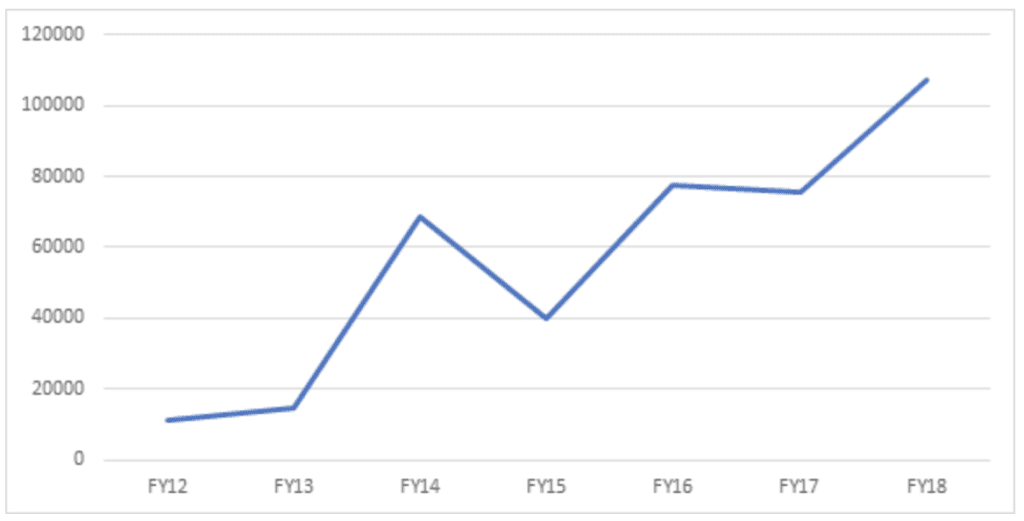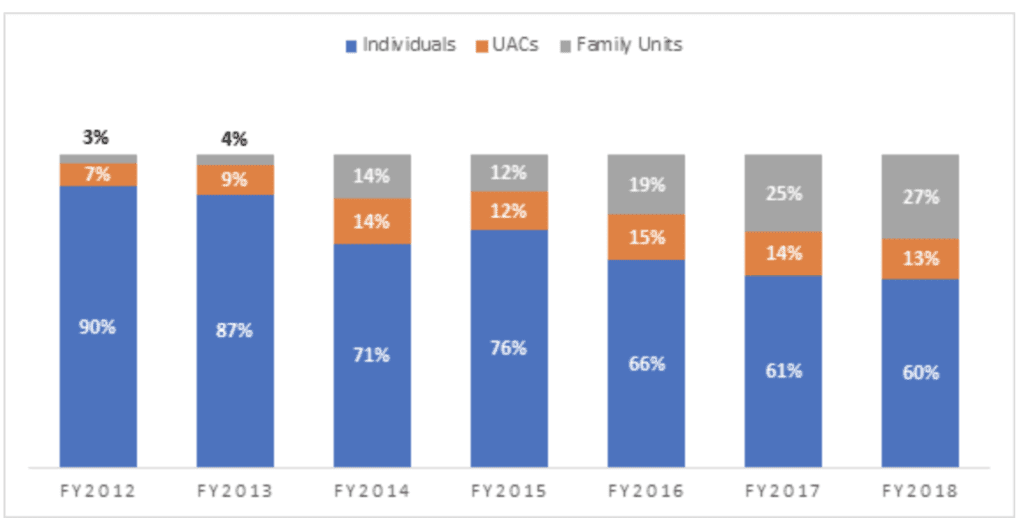2018 Border Apprehensions Confirm Longer-Term Shift to Families and Children
The Brief
Southwest border apprehensions dramatically increased at the end of FY2018 after reverting to pre-FY2017 levels during the fiscal year.
Note: A previous version of this post displayed incorrect data in Figure four. It has been updated.
Earlier this month, we published an analysis of preliminary 2018 apprehension figures at the U.S.-Mexico border. As we noted then, while Fiscal Year (FY) 2018 apprehensions have returned to seasonal levels after a decline in FY2017, and remain low by historical standards, apprehensions of families with asylum claims (in other words, those seeking protection in the United States from prosecution in their home country) have significantly increased over the last three years, presenting a significant new challenge for U.S. border officials. The final FY2018 border apprehension numbers confirm this trend, with family unit apprehensions reaching new historic levels that mark a longer-term migrant challenge for the United States.
Southwest border apprehensions dramatically increased at the end of FY2018 after reverting to pre-FY2017 levels during the fiscal year. As Figure 1 shows, apprehensions dropped dramatically in FY2017 after fluctuating between 2014 and 2015. While FY2018 apprehension figures initially suggested that these levels were returning to FY2016 levels, the increase in family unit apprehensions in August and September boosted overall apprehension numbers at the end of FY2018.
Figure 1: Southwest Border Apprehensions (FY2017-FY2018)

A review of historic apprehension data shows that FY2018 levels are higher than recent years but significantly lower than the peaks in the 1980s and 1990s. As Figure 2 shows, apprehension numbers in FY2018 broke past levels seen between FY2011 and FY2017, including FY2014 when a surge of families and unaccompanied children from Central America arrived in high numbers at the U.S.-Mexico border. However, these numbers remain far below the high levels seen 1986, 1996, 2000, and 2005, reinforcing our conclusion that current apprehension levels do not show that the United States is facing a massive crisis of undocumented immigrants trying to enter the U.S.-Mexico border.
Figure 2: Southwest Border Apprehensions (FY1960-FY2018)

FY2018 apprehension figures confirm that families have emerged as the largest group of migrants detained at the border. As Figure 3 shows, family unit apprehensions (in other words, individuals who are apprehended as part of a family) hit a new historic peak in FY2018 when 107,212 individuals were detained at the border. The increase in family unit apprehensions between July and August 2018 pushed FY2018 levels past the previous peaks in FY2014 and FY2016, reaffirming our observation that the Trump administration’s efforts to deter these migrant flows through policies such as family separations failed to meet these goals.
Figure 3: Southwest Border Family Unit Apprehensions (FY2012-FY2018)

.
Family apprehensions also became a higher percentage of total apprehensions in FY2018. As Figure 4 shows, family unit apprehensions have surged from 3.1 percent of total southwest border apprehensions in FY2012 to 27 percent in FY2018. In contrast, unaccompanied children (UACs) and individual apprehensions formed only 39.6 percent of all apprehensions in the same fiscal year, suggesting that families fleeing from Central America have changed the composition of the migrants arriving at the U.S.-Mexico border over the last three years
Figure 4: Breakdown of Different Categories of Southwest Border Apprehensions (FY2012-FY2018)

This data confirms that the United States is now facing a new challenge at the U.S-Mexico border, one that does not match earlier migration crises. Moving forward, the increase in the number of families leaving El Salvador, Guatemala, and Honduras means that the United States will face the challenge of managing a new influx of people seeking humanitarian protection. However, the scope of this new challenge is significantly smaller than the migrant crises in the 1980s and 1990s where the United States sought to deter large numbers of immigrants coming from Mexico. As a result, the U.S. should aim to provide a proportional response to the current challenge that includes reasonable border security efforts, investments in the immigration asylum system (including immigration courts) and providing aid to sending countries. Rather than using expensive deterrent efforts to tackle a small increase in migrant flows, a proportional response ensures that the United States adequately uses its resources to intelligently manage these longer-term challenges which have accompanied these new shifts in migrant flows.
Share
Read Next
Support Research Like This
With your support, BPC can continue to fund important research like this by combining the best ideas from both parties to promote health, security, and opportunity for all Americans.
Give NowRelated Articles
Join Our Mailing List
BPC drives principled and politically viable policy solutions through the power of rigorous analysis, painstaking negotiation, and aggressive advocacy.